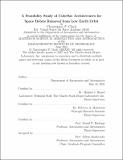A Feasibility Study of CubeSat Architectures for Space Debris Removal from Low Earth Orbit
Author(s)
Clark, Christopher P.
DownloadClark-cpclarkSM-AeroAstro-2021-thesis.pdf (34.75Mb)
Other Contributors
Massachusetts Institute of Technology. Department of Aeronautics and Astronautics.
Advisor
Masterson, Rebecca A.
Hastings, Daniel E.
Ricard, Michael J.
Terms of use
Metadata
Show full item recordAbstract
The rapid increase of space debris in low earth orbit has had tangible impacts on government and commercial missions and caused growing concern among the space community. Removal of collision-prone objects using deorbiter satellites represents a viable strategy for stabilizing the debris population, but the expense and lack of immediate economic benefit reduce the likelihood of decisive action. In an effort to describe a new family of low-cost deorbiter spacecraft, this thesis explores the utility of CubeSats for debris removal. Three of the most widely tested methods for capturing uncooperative debris objects are applied to CubeSat-specific mission scenarios. Limiting factors are noted for each method, and a dynamics simulation is used to approximate success probabilities. Additionally, three deorbit methods using flight-proven technologies are considered for use aboard CubeSats. A satellite design model is developed and integrated with heuristic optimization in order to identify cost-optimal deorbiter CubeSat designs. Results suggest that CubeSats are capable of capturing and deorbiting certain families of debris objects defined by mass and altitude, particularly objects with negligible rotational properties. Feasible CubeSat designs are discovered for all three of the deorbit methods. It is concluded that CubeSat-based debris removal is an area deserving of further exploration, as it could represent a uniquely cost-effective method for removing dangerous debris from low-earth orbit.
Description
Thesis: S.M., Massachusetts Institute of Technology, Department of Aeronautics and Astronautics, June, 2021 Cataloged from the official PDF version of thesis. Includes bibliographical references (pages 231-241).
Date issued
2021Department
Massachusetts Institute of Technology. Department of Aeronautics and AstronauticsPublisher
Massachusetts Institute of Technology
Keywords
Aeronautics and Astronautics.